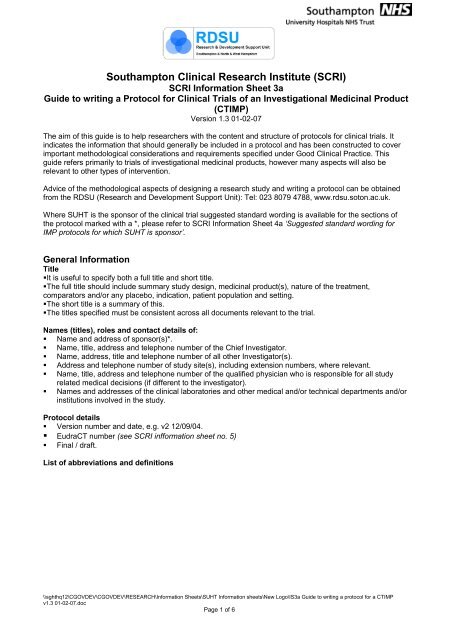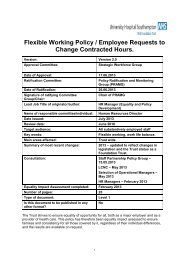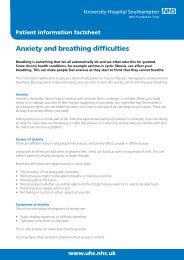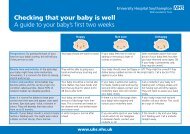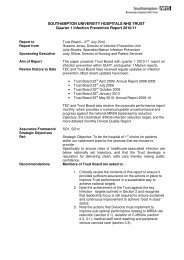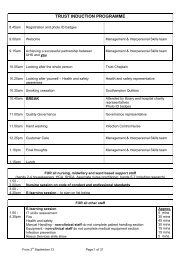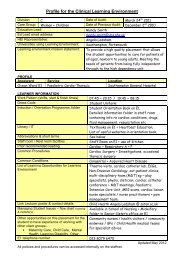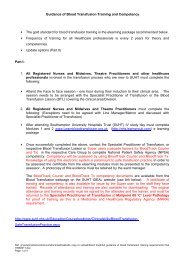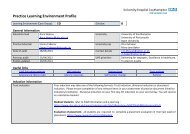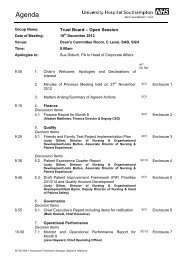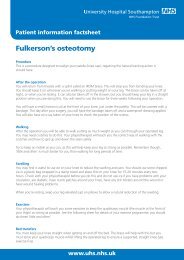Guide to writing a Clinical Trials Protocol - University Hospital ...
Guide to writing a Clinical Trials Protocol - University Hospital ...
Guide to writing a Clinical Trials Protocol - University Hospital ...
You also want an ePaper? Increase the reach of your titles
YUMPU automatically turns print PDFs into web optimized ePapers that Google loves.
Southamp<strong>to</strong>n <strong>Clinical</strong> Research Institute (SCRI)SCRI Information Sheet 3a<strong>Guide</strong> <strong>to</strong> <strong>writing</strong> a Pro<strong>to</strong>col for <strong>Clinical</strong> <strong>Trials</strong> of an Investigational Medicinal Product(CTIMP)Version 1.3 01-02-07The aim of this guide is <strong>to</strong> help researchers with the content and structure of pro<strong>to</strong>cols for clinical trials. Itindicates the information that should generally be included in a pro<strong>to</strong>col and has been constructed <strong>to</strong> coverimportant methodological considerations and requirements specified under Good <strong>Clinical</strong> Practice. Thisguide refers primarily <strong>to</strong> trials of investigational medicinal products, however many aspects will also berelevant <strong>to</strong> other types of intervention.Advice of the methodological aspects of designing a research study and <strong>writing</strong> a pro<strong>to</strong>col can be obtainedfrom the RDSU (Research and Development Support Unit): Tel: 023 8079 4788, www.rdsu.so<strong>to</strong>n.ac.uk.Where SUHT is the sponsor of the clinical trial suggested standard wording is available for the sections ofthe pro<strong>to</strong>col marked with a *, please refer <strong>to</strong> SCRI Information Sheet 4a ‘Suggested standard wording forIMP pro<strong>to</strong>cols for which SUHT is sponsor’.General InformationTitleIt is useful <strong>to</strong> specify both a full title and short title.The full title should include summary study design, medicinal product(s), nature of the treatment,compara<strong>to</strong>rs and/or any placebo, indication, patient population and setting.The short title is a summary of this.The titles specified must be consistent across all documents relevant <strong>to</strong> the trial.Names (titles), roles and contact details of: Name and address of sponsor(s)*. Name, title, address and telephone number of the Chief Investiga<strong>to</strong>r. Name, address, title and telephone number of all other Investiga<strong>to</strong>r(s). Address and telephone number of study site(s), including extension numbers, where relevant. Name, title, address and telephone number of the qualified physician who is responsible for all studyrelated medical decisions (if different <strong>to</strong> the investiga<strong>to</strong>r). Names and addresses of the clinical labora<strong>to</strong>ries and other medical and/or technical departments and/orinstitutions involved in the study.Pro<strong>to</strong>col details Version number and date, e.g. v2 12/09/04. EudraCT number (see SCRI infformation sheet no. 5) Final / draft.List of abbreviations and definitions\\sghthq12\CGOVDEV\CGOVDEV\RESEARCH\Information Sheets\SUHT Information sheets\New Logo\IS3a <strong>Guide</strong> <strong>to</strong> <strong>writing</strong> a pro<strong>to</strong>col for a CTIMPv1.3 01-02-07.docPage 1 of 6
BackgroundThe detail given in this section should be backed up by a full literature review and should make reference <strong>to</strong>relevant papers, previous clinical experience and pilot work.This section should include: A clear explanation of the main research question i.e. the hypothesis <strong>to</strong> be tested. Detailed justification for the trial including:o Explanation of why the study is appropriate, potential benefits <strong>to</strong> patients/ health.o Service, relevance <strong>to</strong> current policies and priorities.o Description of the indication, its diagnosis, incidence, current treatments and their limitations.o Description of the treatment under investigation including reference <strong>to</strong> any previousevidence of its usefulness.o A statement of what would be a worthwhile improvement in study outcomes.o What evidence there is that the treatment under investigation may achieve this.Aims and Objectives State the purpose of performing the study (e.g student project, commercial / non commercial trial,licensing). State the primary and secondary objectives.Study Design – the scientific integrity of a study and the credibility of results obtained are largelydependent upon the study design. A description of the study design should include the following: A description of the of the type/design of the study, e.g. double-blind, placebo controlled, parallel designetc. Phase of the trial (e.g. phase I, II, III, IV or pilot study). Summary of treatments being compared with reasons for choice of comparison group (e.g. active control/placebo). The expected length of time for which each subject will participate in the study for and the sequence andduration of all study periods. Description of all procedures (sequentially) <strong>to</strong> be performed, identifying what is standard and nonstandardcare where possible. The criteria for discontinuation of parts of the study or the entire study. A schematic diagram of the trial design, procedures and stages (can be in a form of a table).Primary and Secondary Endpoints A specific statement of the primary and secondary endpoints, if any, <strong>to</strong> be measured during the study.Trial interventions This refers <strong>to</strong> the treatment under investigation and any active control treatment. Detail in this sectionmay be referenced <strong>to</strong> other documents, such as the Investiga<strong>to</strong>rs Brochure or Summary of ProductCharacteristics or the Data Sheet for Licensed Medicinal Products.General information Full name, generic name (if appropriate) and, if licensed in the UK, the trade name. License information - UK or EU (as appropriate). Summary of known and potential risks and benefits <strong>to</strong> human subjects.Use within the trial Description and justification for the proposed route of administration, dosage, and treatment period. Detail of who will be administering the product (e.g. patient, nurse, doc<strong>to</strong>r, carer). Is the treatment invasive / does it involve radioactive substances? Description of dosage form, packaging and labeling of products. Description of dispensing records, accountability and disposal procedures during the trial. Details of who will supply the products. Other detail including shelf life, arrangements for s<strong>to</strong>rage* etc. Arrangements for continuation of treatment for study patients after the end of the trial.\\sghthq12\CGOVDEV\CGOVDEV\RESEARCH\Information Sheets\SUHT Information sheets\New Logo\IS3a <strong>Guide</strong> <strong>to</strong> <strong>writing</strong> a pro<strong>to</strong>col for a CTIMPv1.3 01-02-07.docPage 2 of 6
Other medications permitted during the trial - include rescue medication (could be standardised for thepurposes of the trial). It is important also <strong>to</strong> consider possible interactions or effects that could confoundresults / conclusions.Subject selection Source of subjects (where they come from and why this group is appropriate). Number of centres involved. Expected number of eligible participants available per year and proportion of these expected <strong>to</strong> agree <strong>to</strong>the trial.Inclusion CriteriaList the inclusion criteria defining who is eligible for the study.Exclusion CriteriaList the exclusion criteria. Consider contra-indications <strong>to</strong> trial treatments, incompatible concurrenttreatments, recent involvement in other research.Subject recruitment Details of recruitment process includingo Method of recruitment (e.g. via adverts, clinics).o Payment of participants.o Details of procedures, tests, screenings carried out <strong>to</strong> assess trial suitability.o Provision of patient information sheet (include as appendix).o Gaining patient consent; how consent will be obtained, who will gain consent, whether awitness will be present, how long the subject will have <strong>to</strong> decide, the arrangements for non-English speakers and special groups (e.g. mentally ill, children, those suffering fromdementia).o Detail of enrolment procedure.Randomisation Including detail and justification for each of the following:o Patient / cluster randomised design (randomising individuals or groups (e.g. generalpractices, wards).o Type of randomisation <strong>to</strong> be used - simple, block, stratified, minimization. If stratified include definition of stratification variables. If blocked define block sizes and whether these will vary.o Use of equal or unequal allocation between treatment arms.o Information regarding how randomisation will be implemented (including who, where, how).o Approach <strong>to</strong> be used <strong>to</strong> conceal allocation (e.g. sealed envelopes, telephone centralallocation office, computerised randomisation etc).Blinding and other measures taken <strong>to</strong> avoid bias Detail and justification for:o Measurements <strong>to</strong> be blinded.o Level of blinding <strong>to</strong> be used – e.g. blinding of participants / investiga<strong>to</strong>rs / assessors (i.e.double blind, single blind, open).o How blinding will be implemented (e.g. through use of identical placebo). Other measures taken <strong>to</strong> minimise / avoid bias.Subject compliance Recording of patient compliance information (what will be recorded, when and where). Detail of follow-up of non compliant subjects.\\sghthq12\CGOVDEV\CGOVDEV\RESEARCH\Information Sheets\SUHT Information sheets\New Logo\IS3a <strong>Guide</strong> <strong>to</strong> <strong>writing</strong> a pro<strong>to</strong>col for a CTIMPv1.3 01-02-07.docPage 3 of 6
Withdrawal of Subjects Subject withdrawal criteria and procedures identifying:o When and how <strong>to</strong> withdraw subjects.o The type and timing of any data <strong>to</strong> be collected for withdrawn subjects.o Whether subject should be replace and if so the methods for doing this.o The follow up procedures for withdrawn subjects.Data collection Provide a detailed list of all data (outcome variables, explana<strong>to</strong>ry variables etc) <strong>to</strong> be collected, with eachdescription including:o Source of the data (e.g. patient questionnaires, patient notes, electronic data, procedure).o Time point for collection (baseline, during treatment, at follow-up point).o Who will collect the data.o Why the data are being collected (e.g. baseline comparison data, main outcome, importantprognostic / explana<strong>to</strong>ry variable).o Whether the data are gathered using a standardised <strong>to</strong>ol (e.g. McGill pain score), by meansof a procedure (in which case full details should be supplied). If a non standard <strong>to</strong>ol is <strong>to</strong> beused, detail on reliability and validity should be given.o What form the data will take (e.g. binary, continuous (numeric), time <strong>to</strong> event). Describe methods used <strong>to</strong> maximise completeness of data (e.g. telephoning patients who have notreturned postal questionnaires). Include data collection forms as appendices.Data handling and record keeping State who is responsible for data collection, recording and quality. Describe procedures for data collection and recording (software <strong>to</strong> be used, location of the data etc). Detail methods implemented <strong>to</strong> ensure validity and quality of data (e.g. double entry, cross validationetc). Describe procedures for security / s<strong>to</strong>rage of data. Describe procedures for retention of source data including the duration and location*. Include statement on adherence <strong>to</strong> Data Protection Act 1998*.Access <strong>to</strong> Source Data Include statement specifying that the Investiga<strong>to</strong>r(s)/Institution will permit moni<strong>to</strong>ring, audits, REC andMHRA review (as applicable) and provide direct access <strong>to</strong> source data and documents.Statistical analysis Detail of the variables <strong>to</strong> be used <strong>to</strong> assess baseline comparability of the randomised groups and howthese will be reported (e.g. means, standard deviations, medians, proportions). Detailed plans for statistical analyses of primary and secondary outcomes including:o Summary measures <strong>to</strong> be reported.o Method of analysis (justified with consideration of assumptions of the method, structure ofthe data (e.g. unpaired, paired, hierarchical) etc).o Plans for handling missing data, non compliers and withdrawals in analysis.o Plans for predefined subgroup analyses. Statement regarding use of intention <strong>to</strong> treat (ITT) or per pro<strong>to</strong>col analysis. Detail of approach for interim analyses and criteria for early termination of the trial. Detail of any non statistical methods that might be used (e.g. qualitative methods). Statement of who will carry out analyses and at what point. State that trial will be reported in accordance with the CONSORT (Consolidated Standards of Reporting<strong>Trials</strong>) statement the results (http://www.consort-statement.org/)\\sghthq12\CGOVDEV\CGOVDEV\RESEARCH\Information Sheets\SUHT Information sheets\New Logo\IS3a <strong>Guide</strong> <strong>to</strong> <strong>writing</strong> a pro<strong>to</strong>col for a CTIMPv1.3 01-02-07.docPage 4 of 6
Sample size calculation Study sample size, for multi-centre studies the projected sample size for each site.o Estimates used (e.g. size of the clinically important effect <strong>to</strong> be detected, drop out / noncompliance rates).o Assumptions made (e.g. assumptions of Normality).o Relevant justification (i.e. appropriate references or clinical arguments).o Allowance for planned subgroup analyses. The power of the study. The level of significance <strong>to</strong> be used. Statistical criteria for terminating the study. Procedures for accounting for missing, unused or counterfeit data. Procedures for reporting any deviations from the statistical plan. The selection of subjects <strong>to</strong> be used in the statistical analyses, e.g. all eligible subjects, all dosedsubjects, all randomised subjects etc. An estimate of the recruitment period for the trial (calculated based on the expected number of eligibleand recruited participants available per year) with justification that the required sample size will beattainable in practice.Safety Assessments Specification of safety parameters and the methods for timing, assessing, recording and analysing safetyparameters. Definition of serious adverse events for the trial which are expected e.g. hospitalization in terminally illpatients. State which serious adverse events will not be reported. Detail the procedures that will be followed in the event of adverse events in the trial*.o Who has what responsibility Describe the type and duration of follow up of subjects required after an adverse event/adverse reaction.S<strong>to</strong>pping/discontinuation rules and breaking of randomisation code Define completion and premature discontinuation of the trial. Describe procedure regarding decisions on discontinuation of the trial (e.g. interim analyses, role of datamoni<strong>to</strong>ring committee). State documentation <strong>to</strong> be completed if part/all of the trial is discontinued. Describe circumstances under which the randomisation codes may need <strong>to</strong> be broken and the procedurefor this.Moni<strong>to</strong>ring Arrangements for moni<strong>to</strong>ring/auditing conduct of the research * . Detail of any other steps taken <strong>to</strong> ensure quality of research. Use and role of data moni<strong>to</strong>ring groups and steering groups etc.ReportingEthical considerations Description of ethical issues for the trial.Ethics and R&D approval A statement that the study will be conducted in accordance with approvals from relevant groups (e.g.MREC, LREC, MHRA, Trust(s))*.\\sghthq12\CGOVDEV\CGOVDEV\RESEARCH\Information Sheets\SUHT Information sheets\New Logo\IS3a <strong>Guide</strong> <strong>to</strong> <strong>writing</strong> a pro<strong>to</strong>col for a CTIMPv1.3 01-02-07.docPage 5 of 6
Research Governance A statement that the study will be conducted in compliance with the Research Governance Frameworkfor Health and Social Care, the Medicine for Human Use (<strong>Clinical</strong> <strong>Trials</strong>) Regulation 2004 and ICH GCP*.Finance Provide any details of the financial arrangements for the study if not assessed in a different document. Provide details of any payments <strong>to</strong> be made <strong>to</strong> participants.Indemnity Describe arrangements for providing cover for non-negligent and negligent harm*Reporting and dissemination Detail of plans for publicising the results of the study including that the trial will be reported in accordancewith the CONSORT (Consolidated Standards of Reporting <strong>Trials</strong>) statement the results(http://www.consort-statement.org/)Tables, figures and referencesAppendicesFor example: Patient information sheet. Patient consent form. GP letter. Data collection forms. Summary of product characteristics. Investiga<strong>to</strong>rs brochure.Adapted with kind permission from UBHT R&D Information Sheet No.1a, v1.0 10-11-04\\sghthq12\CGOVDEV\CGOVDEV\RESEARCH\Information Sheets\SUHT Information sheets\New Logo\IS3a <strong>Guide</strong> <strong>to</strong> <strong>writing</strong> a pro<strong>to</strong>col for a CTIMPv1.3 01-02-07.docPage 6 of 6


